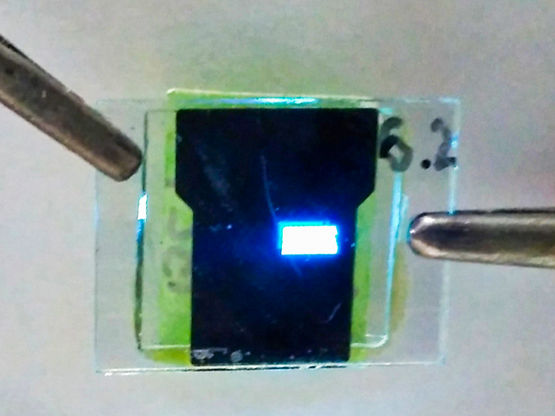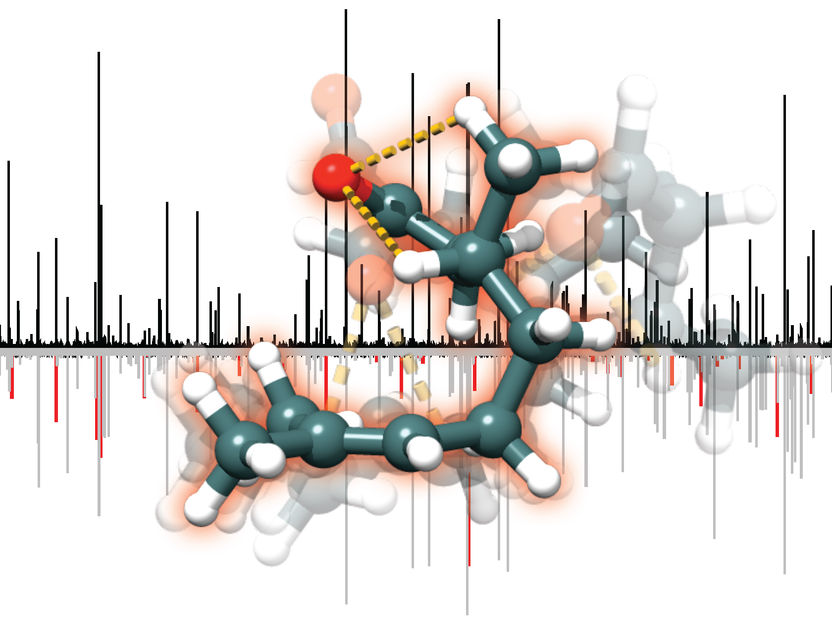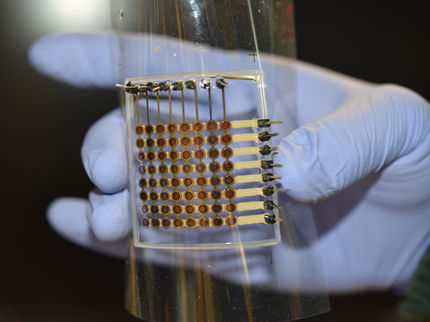Scientists have developed fluorophores that are 2.4 to 20 times more intense than analogues
The new material will help improve displays on smartphones, computers, and televisions
Scientists have developed, synthesized, and studied a series of new fluorophores, a luminous chemical compound. These are the new cyanopyrazine-based bullet systems. Studies have shown that the presence of cyanogroup substance in the composition of fluorophores significantly increases the efficiency of organic light-emitting diodes (OLED). This means that they can be used for create new materials to enhance the brightness of displays on smartphones, computers, and televisions. An article describing the research and its results was published in the journal Dyes and Pigments.

One of the assembled organic LEDs based on push-pull systems containing cyanopyrazine fragment.
Ruslan Gadirov
According to the head of the research team, director of the Postovsky Institute of Organic Synthesis Ural Branch of RAS, member of the Laboratory of Medical Chemistry and Advanced Organic Materials at the Ural Federal University Egor Verbitskiy, physicists knew beforehand that the introduction of cyanogroups in fluorophores can lead to improved properties and overall efficiency of OLEDs.
“Therefore, we modified the pyrazine-based push-pull system with cyanogroup and studied how this affected the photophysical properties of the fluorophores and the performance of OLEDs based on it. The phenomenon of TADF, due to the peculiarities of the structure of the initial substance, did not arise, although there are prerequisites for it. However, it turned out that the introduction of a cyanogroup intensifies intermolecular interactions, as a result of which not individual molecules but complexes of molecules begin to fluoresce. As a consequence, the increase in luminescence intensity was from 2.4 to 20 times, and the brightness of the emitted light was up to 75 times. Such results were shown by several prototype devices made by our colleagues and co-authors from Tomsk State University. It is also important that we used inexpensive and accessible compounds in our research,” says Egor Verbitskiy.
In previous research work, chemists demonstrated that one of the most promising compounds as an acceptor (attracting electrons) part in push-pull systems is the pyrazine ring (another name is 1,4-diazine), a compound of nitrogen, hydrogen and carbon that has a significant electron-accepting effect.
A study of the properties of a wide range of 1,4-diazine-based push-pull systems revealed that the addition of a benzene ring to the pyrazine cycle can improve the efficiency and brightness of the OLEDs produced. At the same time, some of the OLEDs tend to exhibit thermally activated delayed fluorescence (TADF). This is evidenced by the increase in fluorescence lifetime.
It should be noted that scientists of the Postovsky Institute of Organic Synthesis of the Ural Branch of the Russian Academy of Sciences, the Ural Federal University (UrFU, Yekaterinburg), and Tomsk State University are working on the creation of new fluorophores.
Original publication
Other news from the department science

Get the chemical industry in your inbox
By submitting this form you agree that LUMITOS AG will send you the newsletter(s) selected above by email. Your data will not be passed on to third parties. Your data will be stored and processed in accordance with our data protection regulations. LUMITOS may contact you by email for the purpose of advertising or market and opinion surveys. You can revoke your consent at any time without giving reasons to LUMITOS AG, Ernst-Augustin-Str. 2, 12489 Berlin, Germany or by e-mail at revoke@lumitos.com with effect for the future. In addition, each email contains a link to unsubscribe from the corresponding newsletter.
Most read news
More news from our other portals
Last viewed contents
Lehmstedt-Tanasescu_reaction
Nanobiotechnology
Coronium
Dihydrogen_monoxide_hoax

Unexpected flexibility found in odorant molecules - High resolution rotational spectroscopy reveals an unprecedented number of conformations of an odorant molecule – a new world record!

In control of chaos: On the hunt for high entropy crystals - Special synthesis device can test many different chemical mixtures one after the other, as if on an assembly line





























































